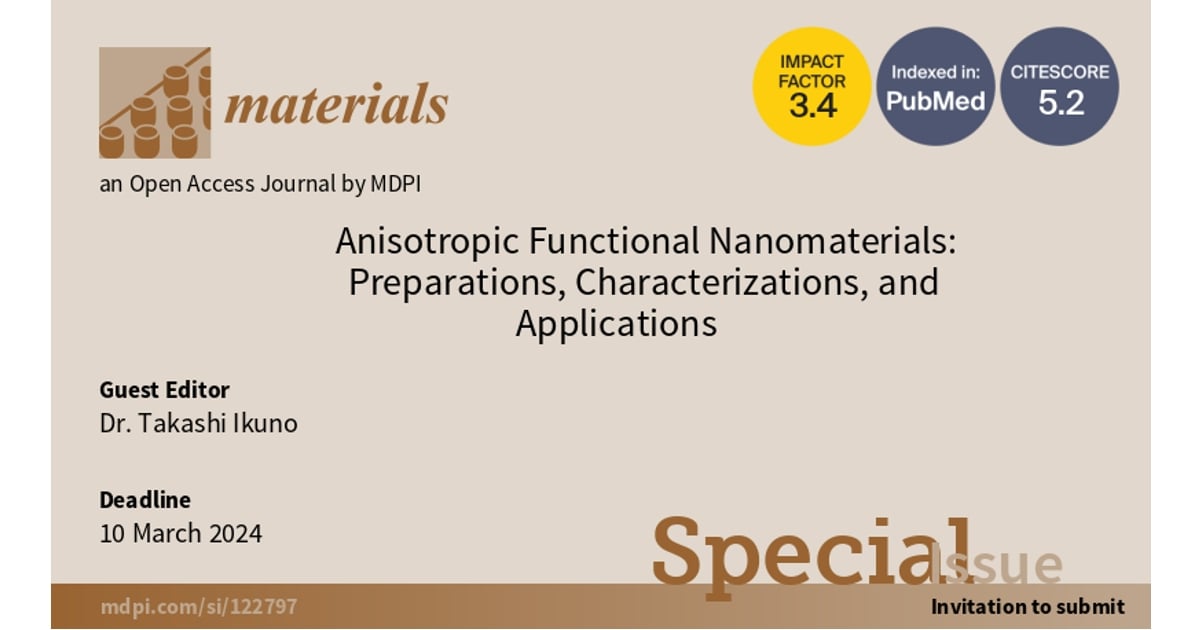Anisotropic Functional Nanomaterials: Preparations, Characterizations, and Applications
A special issue of Materials (ISSN 1996-1944). This special issue belongs to the section "Advanced Nanomaterials and Nanotechnology".
Deadline for manuscript submissions: 31 July 2024 | Viewed by 5962

Special Issue Editor
Special Issue Information
Dear Colleagues,
Anisotropic one- and two-dimensional nanoscale building blocks have fascinating and elegant physical and chemical properties that are dependent on their morphology and dimensions. In addition to the unique properties of anisotropic nanomaterials themselves, new functionalities can be actualized by surface modification and composites of anisotropic nanomaterials. In fact, it is expected that various types of anisotropic nanomaterials will be utilized in modern engineering practice in the near future; for example, different types of nanostructured thin films, fibrous composites, laminates, and multifunctional composites including anisotropic nanomaterials such as carbon nanotubes, semiconductor nanofibers, graphene, atomic-layer crystals of Si and Ge, layered-transition metal dichalcogenides, single-layer crystals of organic semiconductors, biomolecules, and microscopic organisms in semiconductor, battery, aerospace, car industry, or civil engineering applications.
This Special Issue (SI) will compile recent progress in research and development in the field of anisotropic nanomaterials with useful properties, which concerns not only nanotubes, nanowires, nanosheets, and thin films but also surfaces and interfaces. The articles presented in this SI will cover various topics, ranging from but not limited to the optimization of fabrication methods of anisotropic nanomaterials, composite preparations, the functionalization of surfaces, sensors, catalysis, electronic devices, solar cells, energy conversion devices, energy storage devices, and actuators, among others.
Dr. Takashi Ikuno
Guest Editor
Manuscript Submission Information
Manuscripts should be submitted online at www.mdpi.com by registering and logging in to this website. Once you are registered, click here to go to the submission form. Manuscripts can be submitted until the deadline. All submissions that pass pre-check are peer-reviewed. Accepted papers will be published continuously in the journal (as soon as accepted) and will be listed together on the special issue website. Research articles, review articles as well as short communications are invited. For planned papers, a title and short abstract (about 100 words) can be sent to the Editorial Office for announcement on this website.
Submitted manuscripts should not have been published previously, nor be under consideration for publication elsewhere (except conference proceedings papers). All manuscripts are thoroughly refereed through a single-blind peer-review process. A guide for authors and other relevant information for submission of manuscripts is available on the Instructions for Authors page. Materials is an international peer-reviewed open access semimonthly journal published by MDPI.
Please visit the Instructions for Authors page before submitting a manuscript. The Article Processing Charge (APC) for publication in this open access journal is 2600 CHF (Swiss Francs). Submitted papers should be well formatted and use good English. Authors may use MDPI's English editing service prior to publication or during author revisions.
Keywords
- nanocarbon materials
- semiconductor nanowires
- transition metal dichalcogenides
- IV-atomic nanosheets
- nanoribbons
- surface modifications
- surface and interfaces
- heterojunctions
- functional composites
- confined nanostructures
- energy conversion/storage devices
- sensors/actuators
- semiconductor devices






